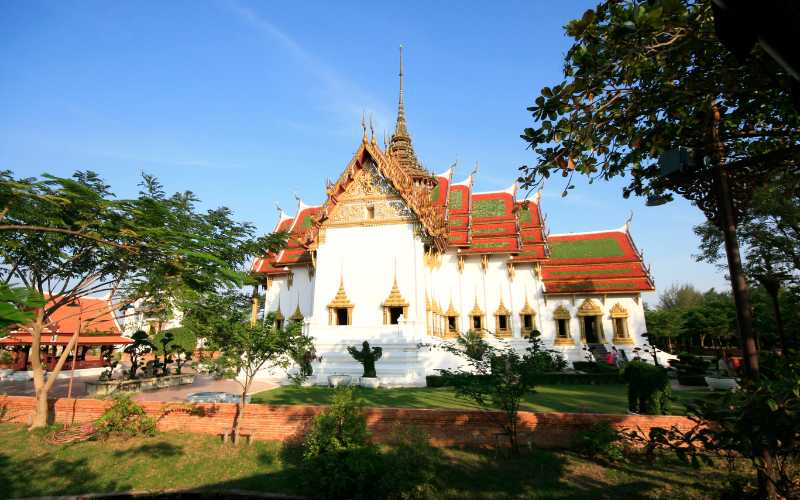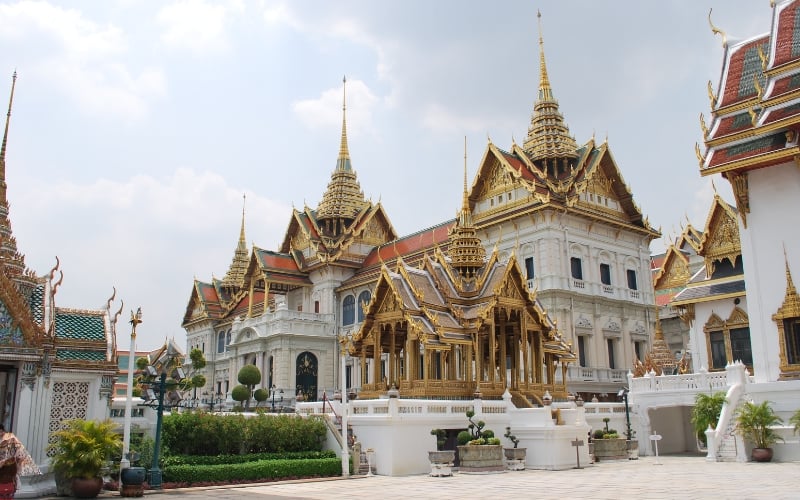Destinations in Thailand are always worth the time and interest because they are filled with incredible stories or distinct traditions. With its innate natural beauty, such a country must have an impressive history behind it. Get to know what this ancient kingdom was and has become in the present day by touring these places.
Also read: 15 Unique Airbnbs in Thailand — From Beachside to Mountain Getaways!
Thailand tourist spots that highlight its history
1. Sukhothai Historical Park

Image credit: icon0.com via Canva Pro
The ancient ruins found inside Sukhothai Historical Park are a sight to behold. The park holds so many historical sites that it will almost take a day to fully explore with a bike or an electric buggy. But every remnant in this park is a story waiting to be told.

Image credit: southtownboy via Canva Pro
If there’s a stupa (a Buddhist place for burial) that you should visit inside this World Heritage Park, it’s Wat Mahathat. Translated as the Temple of the Great Relic, it houses numerous artefacts relevant to Buddhist tradition and practice. For this reason, the stupa is the most important site during Sukhothai’s time as the capital of Thailand. It also exhibits the best examples of Sukhothai architectural arts, such as the mandala design, the lotus bud shape, and sculptures of Buddha around its base.
2. Phanom Rung

Image credit: banjongseal324 via Canva Pro
For a thrilling and enriching look into Thailand culture, you can visit Phanom Rung. This World Heritage site is one of the more popular places to visit in Thailand because of its unique geological placement. This entire Hindu temple complex sits on the rim of a now extinct volcano in Buriram Province for over a millennium.

Image credit: montreehanlue via Canva Pro
Phanom Rung symbolises the Hindu god Shiva’s dwelling, Mount Kailash. Apart from being a significant place of worship, the complex had buildings with many different functions. There’s a pair of libraries, a medical facility, and a shelter for travellers who wish to spend the night inside the complex. It even had a Royal Changing Pavilion for attire changes during important rituals. This proves that Phanom Rung had an important function in communities inside and around it.
Be sure not to miss seeing the Phra Narai Lintel, an invaluable piece of art depicting a reclining Hindu god Vishnu.
3. Ancient Siam

Image credit: zelg via Canva Pro
Ancient Siam is the brainchild of Lek Viriyaphant, a Thai millionaire who had a keen interest in art collection. Over time, he also developed an interest in creating a space for producing replicas of ancient sites or restoring them entirely. He originally wanted to create a golf course to showcase these restorations, but shifted his plans to something more educational as the property developed.

Image credit: Soraluk via Canva Pro
Today, it is the largest outdoor museum in the world and one of the best places to visit in Thailand to learn about its history. It also happens to be shaped like the country itself!
The museum has replicas which showcase the prehistoric architecture throughout Thailand up until the present. Some examples are a replica of The Tiger King’s Palace of Phetchaburi and a restoration of Wat Chong Kham. Ancient Siam closely operates with a team of experts from the National Museum of Thailand to help preserve the history and culture of Thailand.
4. The Bridge on the River Kwai

Image credit: Krzysztof Golik
Thailand prides itself on resisting colonisation from other nations. While this is true, it doesn’t mean that Thailand didn’t suffer from the atrocities of World War II. The world-famous Bridge on the River Kwai serves as a monument to remember the devastation.
Originally intended to be part of the Burma Railway, this bridge was built by a combination of Dutch and British prisoners of war captured by Japan in 1942. Japan occupied Kanchanaburi by then, but the supply line didn’t finish in time. Brutal working conditions by the Imperial Japanese Army led to the death of many POWs during its construction.
While technically known as Bridge 277, it is popularly known as The Bridge on the River Kwai because of the French novel and Hollywood film adaptation. If you ever read or watch both pieces of media, do note that the events depicted in them are heavily fictionalised!
5. Ayutthaya Historical Park

Image credit: karn684 via Canva Pro
The second capital of Thailand also thrived during its time, as evidenced by the expansive ruins of Ayutthaya Historical Park. Ayutthaya was an incredibly busy city during its time as the capital of Siam from 1378 to 1767. Some evidence even suggests that Ayutthaya was linked with the rest of Asia, Arabia, and even Europe. It remains one of the most visited destinations in Thailand, not just by tourists, but locals as well.
Up to this day, it is still considered one of the holiest places to visit in Thailand. The temple of Wat Mahathat, in particular, is sacred as it serves as the site for the first Buddhist university in the country. There are still some monks here who offer to teach tourists how to properly meditate.
Also read: These Are the New UNESCO World Heritage Sites for 2021
Places to visit in Thailand to immerse in the culture
6. The Elephant Jungle Sanctuary

Image credit: Konstantin Symeonidis via Canva Pro
The Thai have a nearly unbreakable affinity with elephants. These majestic animals have lent their strength to the country, from the wars it has fought, to its development as a nation. Over time, their population has unfortunately been exploited for tourism, while logging threatens their natural habitats. This is why The Elephant Jungle Sanctuary dedicates itself to the preservation of Indian elephants, which are subspecies of Asian elephants in Thailand. It also wants to spread awareness about preventing activities that may harm elephants in the future.
The Elephant Jungle Sanctuary has many sites all across Thailand, but its flagship location sits in Chiang Mai. Visitors can book tours to enjoy the company of these gentle giants while also being educated about preservation practices for the elephants. Should you want to observe ethics during your trip, this is one of the best destinations in Thailand to go to.
Also read: 9 Ethical Animal Sanctuaries That You Can Visit in Thailand
7. New Lumpinee Stadium

Image credit: Mr.Peerapong Prasutr
Muay Thai may be elegant to look at, but it is definitely not for the squeamish. Still, there’s no denying that “the art of eight limbs” is an important part of Thailand culture and history. Its role in ancient festivals provided spectacles for royalty and peasants alike. Its practical use also meant that soldiers in the military had to learn it.

Image credit: Mr.Sayompoo Setabhrahmana
Today, it is an exciting sport that draws locals and travellers alike. Prestigious fights are often held in New Lumpinee Stadium in Bangkok. Originally built in 1956, it is an overhauled iteration of the old stadium and attracts numerous combat sports enthusiasts.
The Royal Thai Army is in charge of managing this prolific stadium, which holds matches three times a week. If you’re just looking for intense flying knees and elbows, New Lumpinee Stadium only has room for the most exciting fights around.
8. The Grand Palace

Image credit: TJ Alex via Canva Pro
Located right in the heart of Bangkok, no visit to Thailand would be complete without going to the Grand Palace. This complex of buildings has multiple functions but it is most famous as the residence of the royal family ever since the city became Thailand’s capital. Some structures serve as administrative offices or ceremonial rooms for rituals. The palace complex also serves as accommodations for foreign VIPs, ambassadors, and dignitaries.

Image credit: richliy via Canva Pro
To truly understand the importance of the Grand Palace, it may be wise to book a day tour. The complex has dedicated quarters which specify its functions. Given its vast size, average tour times may take up to half a day for a thorough explanation of the structures. But make no mistake, everything that your eyes will see in the Grand Palace is breathtakingly beautiful, from the architecture, all the way to the art you’ll see inside its rooms.
Also read: 20 Bucket List Experiences for First-Timers in Bangkok!
9. Ban Chiang

Image credit: xiquinhosilva
Considered one of the most important archaeological sites in Southeast Asia, Ban Chiang has always fascinated historians even before it became a Thailand tourist spot. It has been widely theorised that this site was a cultural hub of a prehistoric civilization, thousands of years before Siam and Thailand were ever a possibility.
The historic site had evidence of advanced metallurgy. Iron casting and bronzework tools from the site were found to be at least 4,000 years old. Aside from metalwork, distinct red pots were also unearthed. Historians suggest that the ancient civilization residing in Ban Chiang used these pots for cultural and social trades with other civilizations.

Image credit: User:Mattes
Some of these pots were looted by locals because of their value. A few artefacts have been recovered, which people can see in the Ban Chiang National Museum.
10. Khao Yai National Park

Image credit: Axel Drainville
Khao Yai is one of the most important destinations in Thailand because it is the first national park to be established in the country. It is the third-largest national park in Thailand, located west of the Sankamphaeng Mountain Range. Numerous flora and fauna consider this national park their home, and it is one of the few habitats where wild animals like elephants and black bears can roam freely. At some point, before it became a national park, it even managed to hide criminals from the law because of its remoteness.

Image credit: kidsada Manchinda via Canva Pro
There is no shortage of beautiful waterfalls in Khao Yai National Park, all of which are easily accessible. The tallest is Haew Narok Waterfall, spanning 150m. Pha Kluai Mai Waterfall, aside from being a sight to behold, is also famous for its surrounding orchids. Finally, while the basin of Haew Su Wat Waterfall is great for swimming, local authorities prohibit the activity due to turbulent flood waters.
Also read: 10 Best Heritage Towns in Asia That You Should Not Miss
There are still so many activities that travellers can do when going to Thailand tourist spots. Each of them will help you know Thailand a little bit better. But for a trip that aims to provide more context behind its culture and history, these are some of the best places to visit in Thailand.
Featured image credit: Siraphol via Canva Pro





